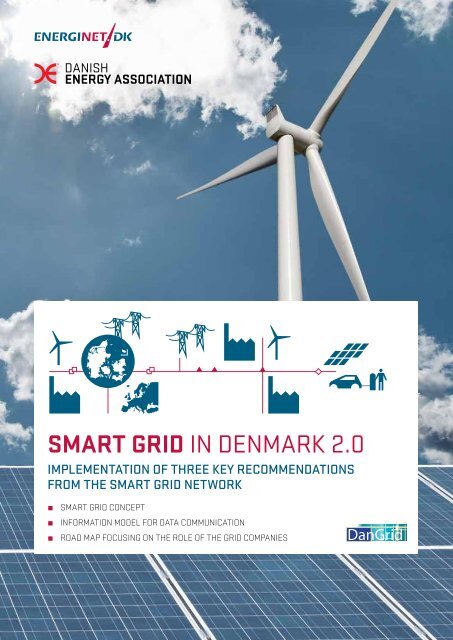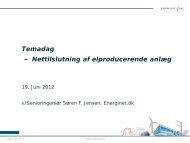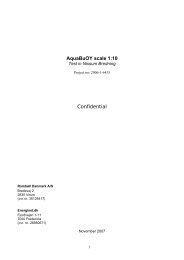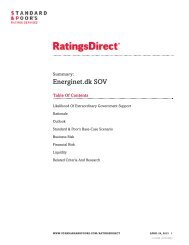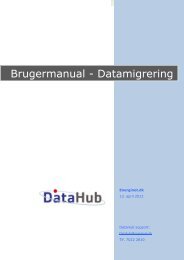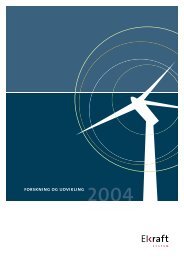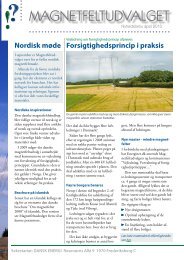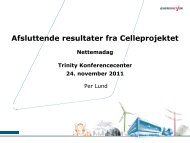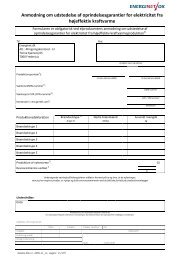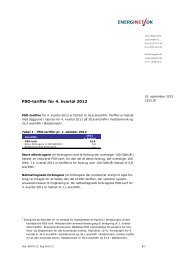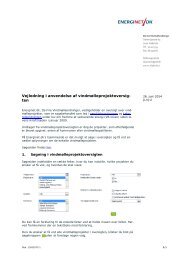smart griD IN DENmARK 2.0 - Energinet.dk
smart griD IN DENmARK 2.0 - Energinet.dk
smart griD IN DENmARK 2.0 - Energinet.dk
- No tags were found...
Create successful ePaper yourself
Turn your PDF publications into a flip-book with our unique Google optimized e-Paper software.
<strong>smart</strong> grid <strong>IN</strong> DENMARK <strong>2.0</strong> | 3CONTENTS// SUMMARY 51 // <strong>IN</strong>TRODUCTION 81.1 THE FUTURE HOLDS NEW CHALLENGES FOR THE POWER SYSTEM 81.2 SMART GRID CHEAPER THAN TRADITIONAL TECHNOLOGY 92 // THE COURSE IS SET 103 // ROLES AND RESPONSIBILITIES <strong>IN</strong> TOMORROW’S 11POWER SYSTEM3.1 WHO REQUESTS FLEXIBILITY? 113.2 WHO OFFERS FLEXIBILITY? 123.3 WHO HANDLES FLEXIBILITY? 134 // FOCUS ON MARKET ACCESS 154.1 THE MARKET DOES NOT SOLVE EVERYTH<strong>IN</strong>G 175 // DATA COMMUNICATION 186 // BENEFITS OF THE CONCEPT 207 // CONVERT<strong>IN</strong>G THE POWER GRID TO A SMART GRID 228 // ROAD MAP FOCUS<strong>IN</strong>G ON THE ROLE 23OF THE GRID COMPANIES8.1 DECID<strong>IN</strong>G BUS<strong>IN</strong>ESS CASE AND STRATEGY 268.2 NEW TECHNOLOGY <strong>IN</strong> THE POWER GRID 278.3 ACTIVAT<strong>IN</strong>G CUSTOMERS’ FLEXIBLE ELECTRICITY CONSUMPTION 288.4 OTHER MEASURES 29
4 | <strong>smart</strong> grid <strong>IN</strong> DENMARK <strong>2.0</strong>
<strong>smart</strong> grid <strong>IN</strong> DENMARK <strong>2.0</strong> | 5// SUMMARYIn 2011, the Smart Grid Network, set up by the Danish Minister for Climate and Energyin 2010, published a report that points to 35 recommendations which each contributeto establishing a Smart Grid in Denmark. This report has been prepared by the DanishEnergy Association and <strong>Energinet</strong>.<strong>dk</strong> and looks at three of these recommendations ingreater detail:Concept for power system operation (Smart Grid Network recommendation no. 22)Information model for data communication (Smart Grid Network recommendation no. 23)Road map for roll-out of the Smart Grid (Smart Grid Network recommendation no. 24)SMART GRID CONCEPT<strong>Energinet</strong>.<strong>dk</strong> and the Danish Energy Association havejointly developed a Smart Grid concept which canbe used to mobilise and activate flexible electricityconsumption and production from small customers– flexibility that would otherwise have remained unutilisedin the power system.With the establishment of a Smart Grid conceptcomes an invitation to suppliers and other players todevelop new solutions and products to support theconcept.The concept mobilises and activates flexible electricityconsumption and production from smallcustomers. This happens through customers or appliancesconnected to the power system changingtheir behaviour – as and when requested – to fulfilthe needs of the power system. For example, a heatpump might stop because a power line is overloaded,or an electric car adapts its charging pattern to balanceout fluctuating wind power or solar energy levels.This flexibility is sought by grid companies to reduceand defer investments in the distribution grids andby <strong>Energinet</strong>.<strong>dk</strong> (the transmission system operator,TSO) to balance the entire power system.Commercial players handle the flexibility, and competeon equal terms to deliver the most efficientand innovative product. The commercial players willprobably gather a sufficient volume of flexibility andoffer it to grid companies and <strong>Energinet</strong>.<strong>dk</strong>, which areexpected to only want to contact a limited number ofplaces in order to mobilise and activate the flexibleelectricity consumption and production.The concept distinguishes between two differentmechanisms for activating flexibility. The first is theuse of price signals (variable grid tariffs and electricityprices), which give customers a financial incentiveto shift their electricity consumption and productionto times of day when it is less inconvenient forthe power system. The second is flexibility products,where a pre-arranged and clearly specified service –for example reducing the load in a particular grid area– can be activated as required by the grid companiesand/or <strong>Energinet</strong>.<strong>dk</strong> for an agreed price.The use of price signals is an important element inreleasing the value of flexible electricity consumptionand production, but it is not enough on its own asthe response to the price signals cannot be guaranteedin advance. Trading in flexibility products is thesupplementary measure which ensures that specificneeds for flexibility can be met at all times.The aim of the concept is, therefore, the establishmentin the long term of a fully functional market fortrading in standardised flexibility products. To beginwith, the trading in flexibility is expected to take placebilaterally, and for a transitional period via a simplemarket place acting as a display window for confirmedflexibility agreements.The concept ties in well with the act which has recentlybeen passed on the so-called wholesale model,which defines the future distribution of roles inthe electricity market where the grid companies arenot in direct contact with individual customers. Theproposed concept therefore does not require a directbusiness connection between grid companies andcustomers as the flexibility will be exploited via thecommercial players.
6 | <strong>smart</strong> grid <strong>IN</strong> DENMARK <strong>2.0</strong>Fig.ROLESkap3_RollerAND RESPONSIBILITIESPRIVATE PLAYERSCOMMERCIAL PLAYERSSYSTEM OPERATORSMM MBALANCECUSTOMERSHEAT PUMPSELECTRIC VEHICLESELECTRICITYSUPPLIERSAGGREGATORSNEW PLAYERSBALANCE-RESPONSIBLEPARTIESGRID COMPANIESCONGESTIONOFFERHANDLEREQUESTTHE PRIVATE PLAYERS offer flexibility, which is handled by the commercial players to <strong>Energinet</strong>.<strong>dk</strong> and the grid companies<strong>IN</strong>FORMATION Fig. kap5_informationsmodelMODEL FOR DATAROAD MAP FOCUS<strong>IN</strong>G ON THE ROLE OFCOMMUNICATIONTHE GRID COMPANIESTomorrow’s power system is complex, with numerousThe challenges to the distribution grid resultalsphysical units, businesses and private individuingfrom new electricity consumption and decenCOMPONENT-ORIENTEDactively involved in the power system. Likewise, SYSTEM-ORIENTEDtralised production can be handled via traditional gridtheIECvolume61850 ETC.of(LOGICALnecessaryNODES)information which must beIEC 61970expansionETC. (CIM)or by exploiting the possibilities offeredgathered, communicated and processed will grow by flexible electricity consumption and production.dramatically, and it is therefore crucial that a fully In a report published in 2010 (Smart Grid in Denmark),functional IT infrastructure is in place.<strong>Energinet</strong>.<strong>dk</strong> and the Danish Energy AssociationPRIVATE PLAYERSCOMMERCIAL PLAYERSSYSTEM OPERATORScon cluded, based on their analyses, that a SmartA central element is a harmonised information model Grid – compared with traditional expansion – BALANCE is, fromin the Danish power system. The concept therefore a socio-economic perspective, the most efficientpoints to using international standards to define method of addressing future challenges.an information model. The choice of standards hasMM MCUSTOMERSHEAT PUMPSELECTRIC VEHICLESELECTRICITYSUPPLIERSAGGREGATORSNEW PLAYERStaken account of international developments in thearea, and ensures an efficient way of integrating differentplayers, components and customers. It means,for example, that the cost of mobilising flexible electricityconsumption and production is reduced if individualappliances are, from the outset, designedso they can be monitored and remotely controlled instandardised ways.BALANCE-RESPONSIBLEThe present report points to a need to remove twoPARTIESkey barriers. The firstGRIDbarrierCOMPANIESis constitutedCONGESTIONby thefact that the existing regulation does not support gridcompanies using Smart Grid technology in the electricitygrid. The second barrier is that, at present, gridcompanies do not have a real option of using pricesignals as a means of activating customers’ flexibility.Today there are 3.2 million electricity customerswho are not subject to hourly settlement and thereforedo not have a financial incentive to respond toprice signals.Fig. kap3_MarkedCOMMERCIAL PLAYERSEXIST<strong>IN</strong>GMARKETSIn preparing this report, a road map has been developedthat focuses in particular on the role of thegrid companies, describing the key steps towardsestablishing a Smart Grid. The road map sets out anumber of measures which must be implemented asSYSTEM OPERATORSwell as when they should be implemented. Section 8describes the individual measures in detail. BALANCECOORD<strong>IN</strong>ATIONELECTRICITYSUPPLIERSAGGREGATORSNEW PLAYERSBALANCE-RESPONSIBLEPARTIESNEW MARKETFOR FLEXIBILITYGRID COMPANIESCONGESTION
8 | <strong>smart</strong> grid <strong>IN</strong> DENMARK <strong>2.0</strong>1 // <strong>IN</strong>TRODUCTIONIn 2010, the Danish Minister for Climate and Energy set up the Smart Grid Networkinvolving representatives from the entire energy sector. The network was tasked withpreparing recommendations for future measures and initiatives that would make itpossible to handle up to 50% wind power in the power system in 2020. In 2011, theSmart Grid Network published a report which points to 35 recommendations, whicheach contribute to establishing a Smart Grid in DenmarkThe Danish Minister for Climate, Energy and BuildingMartin Lidegaard has commissioned the preparationof a strategy for establishing a Smart Grid in Denmark.This strategy will be published before the endof 2012. The Smart Grid Network’s recommendationsare a key element in preparing the strategy.This report has been prepared by the Danish EnergyAssociation and <strong>Energinet</strong>.<strong>dk</strong> in a partnership calledDanGrid and looks at three recommendations fromthe Smart Grid Network. “Concept for power systemoperation”, “Information model for data communication”and “Road map for roll-out of the Smart Grid”.1.1 // the fUTURE HOLDS NEWCHALLENGES FOR THE POWER SYSTEMThe Danish government’s goal is for Denmark’s entireenergy needs to be met by renewable energy in 2050.The government’s goal assumes the phasing-in ofrenewable energy on a massive scale, and by 2020half of Denmark’s traditional electricity consumptionmust come from wind power.At the same time, consumers are expected to replacetheir oil-fired boilers with electric heat pumps,install solar cells on their roofs and replace their petrolor diesel-powered vehicles with electric cars.A detailed description of the individual recommendationscan be found in three subreports which can beseen on the <strong>Energinet</strong>.<strong>dk</strong> and the Danish Energy Associationwebsites (Danish only).
10 | <strong>smart</strong> grid <strong>IN</strong> DENMARK <strong>2.0</strong>2 // THE COURSE IS SET<strong>Energinet</strong>.<strong>dk</strong> and the Danish Energy Association have together developed a Smart Gridconcept that focuses on involving commercial players and mobilising flexible electricityconsumption and production from smaller customersThe concept must be seen as a further developmentof the existing power system where primary and localpower stations and major consumption units todaycontribute ancillary services for controlling and balancingthe power system.With the establishment of a joint Smart Grid conceptcomes an invitation from the electricity sector (<strong>Energinet</strong>.<strong>dk</strong>and the grid companies) for suppliers andother players to develop new solutions and productsto support the concept.ELECTRICITY <strong>IN</strong>DUSTRY AGREES ON A JO<strong>IN</strong>T SMART GRID CONCEPT¼ This report, which has been prepared by <strong>Energinet</strong>.<strong>dk</strong> and the Danish Energy Association, presents aconcept for a Danish Smart Grid.¼ The concept is based on the mobilisation of currently unused and potentially cheaper resources, i.e.flexible electricity consumption and production, leading to socio-economic benefits. Mobilisation involvesusing the properties of electricity-consuming and electricity-producing resources to control activepower output as well as activating their potential voltage-control properties.¼ The concept creates a framework which will allow all the players involved to create additional valueby activating what is today an unused resource, i.e. the flexibility of the electricity consumption andproduction of even smaller customers.ELECTRICITY SECTOR <strong>IN</strong>VITES PLAYERS TO DEVELOP SOLUTIONS AND PRODUCTS AIMED ATSUPPORT<strong>IN</strong>G THE JO<strong>IN</strong>T CONCEPT¼ With this joint concept, the electricity sector is providing the direction for a Danish Smart Grid, andplayers in the electricity sector are hereby invited to develop new solutions and products to support theconcept.¼ The concept describes a market-based method for mobilising the potentially flexible properties of bothelectricity consumption and production in the power system. Priority is being given to ensuring that theresources’ flexibility is made available to markets voluntarily and, in so far as is possible, to maintainingthe power system’s stability and security of supply.¼ Where participation in markets is voluntary, it is still necessary to comply with relevant technical regulations.This will ensure that units which are technically capable can actually also contribute to, forexample, frequency stability and voltage quality in the power system.
<strong>smart</strong> grid <strong>IN</strong> DENMARK <strong>2.0</strong> | 113 // ROLES AND RESPONSIBILITIES<strong>IN</strong> TOMORROW’S POWER SYSTEMThe proposed Smart Grid concept will involve the power system’s current players, butnew players will be added, and the roles of existing players will change to match the newsituationOne of the concept’s main ideas is to mobilise andactivate flexibility from distributed units. This sectiondescribes the players which are central in requesting,handling and offering flexibility in tomorrow’s SmartGrid.3.1 // WHO REQUESTS FLEXIBILITY?The primary players requesting flexibility are thesystem operators, i.e. the grid companies and<strong>Energinet</strong>.<strong>dk</strong>. The grid companies want the flexibilityto reduce and defer investments in the distributiongrids, while <strong>Energinet</strong>.<strong>dk</strong> will request flexibility toensure system balance throughout the entire powersystem.To handle the task of ensuring balance in the powersystem, well-established markets already existwhere <strong>Energinet</strong>.<strong>dk</strong> procures the required flexibility,for example the joint Nordic regulating power market(NOIS). In the proposed Smart Grid concept, this willnot change, just as <strong>Energinet</strong>.<strong>dk</strong>’s role in general willnot be significantly modified. <strong>Energinet</strong>.<strong>dk</strong> will, however,be given access to new ways of ensuring systembalance by buying the new flexibility productswhich are mobilised by the concept.WHAT IS “FLEXIBILITY”?¼ In this context, flexibility means that a customer, or an appliance connected to the power system,changes its behaviour to meet a need from the power system. For example, a heat pump that stopsbecause a power line is overloaded, an electric car that adapts its charging patterns to balance outfluctuating wind power or solar energy levels, or a customer choosing to use their tumble-dryer laterthan planned.ROLES AND RESPONSIBILITIESFig. kap3_RollerPRIVATE PLAYERSCOMMERCIAL PLAYERSSYSTEM OPERATORSMM MBALANCECUSTOMERSHEAT PUMPSELECTRIC VEHICLESELECTRICITYSUPPLIERSAGGREGATORSNEW PLAYERSBALANCE-RESPONSIBLEPARTIESGRID COMPANIESCONGESTIONOFFERHANDLEREQUESTTHE PRIVATE PLAYERS offer the flexibility which is handled by the commercial players to <strong>Energinet</strong>.<strong>dk</strong> and the grid companies.Fig. kap5_informationsmodel
<strong>smart</strong> grid <strong>IN</strong> DENMARK <strong>2.0</strong> | 13COMMERCIAL PLAYERS¼ The commercial players operate freely on commercial terms in the power system – typically balanceresponsibleparties (BRPs), electricity suppliers and aggregators.¼ The BRPs have a formal legal role and are responsible for supplying the expected and reported productsin the electricity markets such as Elspot, regulating power and the reserve capacity markets. Thismeans that all electricity production and consumption in Denmark must be registered with the BRPs.¼An important role in tomorrow’s power system is that of the aggregator, which on the one hand handlesflexibility at the retail level by offering solutions that make it interesting for customers to offer flexibility,and on the other gathers and administers (aggregates) individual flexibility in sufficiently largevolumes for it to be procured and activated as a combined service via the wholesale markets. Theaggregator role can overlap with that of the BRP or be an independent commercial function which isoffered by new or existing players in the market.Finally, the central electricity-generating units, suchas power stations and wind farms, will carry on playingan important role in maintaining stability in tomorrow’spower system. A significant proportion ofthe flexibility sought by <strong>Energinet</strong>.<strong>dk</strong> will probably stillbe supplied by these units.3.3 // WHO HANDLES FLEXIBILITY?In the concept, flexibility will be handled betweenthose offering it and those requesting it by a numberof commercial players who will compete on equalterms to be the most efficient and innovative.Today, the BRPs already serve as the link between thewholesale and retail markets for electricity, and theyare, among other things, responsible for submittingplans for total electricity production and consumption.In the Smart Grid concept, it is therefore natural,once the market for trading in flexibility has achieveda sufficiently large volume in the future, that theBRPs also become responsible for registering andreporting the flexibility products.<strong>Energinet</strong>.<strong>dk</strong> and the grid companies are expected tostill only want to have to contact a limited number ofplaces to mobilise and activate a flexibility product.
14 | <strong>smart</strong> grid <strong>IN</strong> DENMARK <strong>2.0</strong>The BRPs will probably gather a sufficient volumeof flexibility products via their own aggregator functions,via other commercial aggregators or directlyvia local production units.The aggregator role is also expected to be key tomobilising and activating DER and customers. Viathe active marketing of good business offers andconcepts, the aggregators must make it interestingfor private players to be flexible in their electricityconsumption and/or own production. Moreover, eitherthey themselves or their business partners willsupply systems to the private players to ensure thatthey will not necessarily have to take any active stepswhen a flexibility product is activated. It is importantthat the flexibility can be activated without the activeinvolvement of the customer, but always takingaccount of the customer’s preferences and comfortrequirements.Today, the aggregator role is already being performedby some BRPs in relation to, for example, smallerCHP units which supply different types of ancillaryservices. However, in future, this role will involve farmore customers and appliances which can be activated,and the assumption is that new players willemerge as a result. These might specialise in, forexample, recharging electric vehicles or controllingheat pumps, with their business solely concentratingon the special properties of selected technologies.EXAMPLE – AN AGGREGATOR OFFERS TOCONTROL A CUSTOMER’S HEAT PUMP¼ In tomorrow’s power system, an aggregatorcan, for example, be a player who specialisesin controlling heat pumps for customersand activating the flexibility whichthe heat pump can deliver.¼ A customer with a heat pump wants tomaintain an indoor temperature whichsatisfies his comfort requirements (forexample 20-22°C during the day and 16-18°C at night). The heat pump uses 3,000kWh of electricity a year, and the customerpays DKK 2/kWh, corresponding to anannual cost of DKK 6,000.¼ The aggregator offers to supply the electricityand assume control of the heatpump while guaranteeing a temperaturewhich lies within the customer’s comfortzone. The customer pays DKK 5,500 ayear for the service and thus saves DKK500 relative to what he paid previously.¼ Using controls and automation, the aggregatorswitches off the heat pump forshort periods when electricity prices arehigh without the temperature in the housefalling outside the customer’s comfortzone, and reduces the annual cost ofpowering the heat pump by DKK 500 ayear. The aggregator also switches theheat pump on and off when it benefits thepower system, earning a further DKK 250by selling these services on market terms.The aggregator has thus reduced the costof operating the heat pump to DKK 5,250a year. He receives payment of DKK 5,500from the customer and thereby earns DKK250 a year.¼ This is a fictive example, but it shows thatboth the customer and the aggregatorstand to gain from the heat pump’s flexibleelectricity consumption being utilisedby the power system. The customeris offered an attractive solution (maintaininga comfort zone temperature anda cheaper electricity bill), which makes itinteresting for him to offer his flexibility tothe market (by handing over control of theheat pump to the aggregator).
Fig. kap3_RollerPRIVATE PLAYERSCOMMERCIAL PLAYERS<strong>smart</strong> grid <strong>IN</strong> DENMARK <strong>2.0</strong> | 15SYSTEM OPERATORSMM M4 // FOCUS ON MARKET ACCESSCUSTOMERSHEAT PUMPSELECTRIC VEHICLESELECTRICITYSUPPLIERSAGGREGATORSNEW PLAYERSToday, markets have already been established whereBALANCE-RESPONSIBLE <strong>Energinet</strong>.<strong>dk</strong> procures flexibility products, for examplethe common Nordic GRID COMPANIES regulating power CONGESTION marketPARTIES(NOIS). However, there is no similar trading platformwhich allows the grid companies to utilise flexibilityproducts as an alternative to grid reinforcements.BALANCE-RESPONSIBLEPARTIESGRID COMPANIESBALANCECONGESTIONIt is central to the concept that mobilising and activating flexibility must be marketbased.This means that the private players must be free to decide to whom and to whatOFFERHANDLEREQUESTextent they offer their flexibility, and it must be ensured that the flexibility is priced andsold transparentlyTWO DIFFERENT MECHANISMS – PRICE SIGNALS AND FLEXIBILITY PRODUCTSFig. kap5_informationsmodelThe concept basically distinguishes between two different mechanisms for activating flexibility:¼ PRICE SIGNALS (variable grid tariffs and electricity prices), providing a general incentive for customersCOMPONENT-ORIENTEDto shift their electricity consumption and production SYSTEM-ORIENTEDto times which are less inconvenient for the powerIEC 61850 system. ETC. (LOGICAL NODES)IEC 61970 ETC. (CIM)¼ FLEXIBILITY PRODUCTS, where a service which has been clearly agreed and defined in advance – forexample reducing the load in a specified grid area – can be activated as and when needed by grid companiesPLAYERS and/or <strong>Energinet</strong>.<strong>dk</strong> at an agreed COMMERCIAL price. PLAYERSSYSTEM PRIVATE OPERATORSMM MThe use of price signals is central to releasing theELECTRICITYvalue CUSTOMERS of flexible electricity HEAT PUMPSconsumption and SUPPLIERS production.However, price signals are not sufficient on theirELECTRIC VEHICLESAGGREGATORSNEW PLAYERSown as the response to the price signals cannot beguaranteed in advance. Trading in flexibility productsis the supplementary measure which ensures thatspecific needs for flexibility can be met at all times.The aim of the concept is therefore, in the long term,to establish an efficient market for trading in standardisedflexibility products.BALANCEFig. MARKETS kap3_Marked FOR FLEXIBILITYCOMMERCIAL PLAYERSEXIST<strong>IN</strong>GMARKETSSYSTEM OPERATORSBALANCECOORD<strong>IN</strong>ATIONELECTRICITYSUPPLIERSAGGREGATORSNEW PLAYERSBALANCE-RESPONSIBLEPARTIESNEW MARKETFOR FLEXIBILITYGRID COMPANIESCONGESTIONA NEW MARKET for flexibility makes it possible for the grid companies to purchase flexibility products as an alternative to grid reinforcements. The newmarket will be coordinated with the existing markets for flexibility, for example the regulating power market.
16 | <strong>smart</strong> grid <strong>IN</strong> DENMARK <strong>2.0</strong>GRID COMPANIES AND ENERG<strong>IN</strong>ET.DK HAVE DIFFER<strong>IN</strong>G NEEDS¼ <strong>Energinet</strong>.<strong>dk</strong> needs flexibility services in order to meet its obligation to guarantee system balance. Thegrid companies’ demand for flexibility primarily springs from their need to counter situations of localoverload in the distribution grid. <strong>Energinet</strong>.<strong>dk</strong> therefore demands relatively large volumes of power, butcan, on the other hand, use resources from all over northern Europe, except in cases of congestion inthe transmission grid. By contrast, a grid company will usually demand significantly less power which,however, must be very precisely localised in relation to the overloaded grid area – perhaps down to thelevel of an individual district or street, or concentrated on a single major consumption or productionunit.Flexibility products targeted at grid companies are,initially, expected to be traded via bilateral agreements,then via a simple market place for flexibilityproducts (display window) and finally via a formalmarket for trading in standardised flexibility products.This will introduce new ways for the grid companiesto procure flexibility products as an alternativeto grid reinforcements.It is important that trading in flexibility to overcomesituations of local overload in the distribution grid iscoupled with existing markets for flexibility for bal-an cing purposes, especially the joint Nordic regula t-ing power market (NOIS). This ensures synergies sothat flexible services which are available to the gridcompanies are also available to <strong>Energinet</strong>.<strong>dk</strong>, sothat activating resources on the part of <strong>Energinet</strong>.<strong>dk</strong>takes account of the operational status of the distributiongrid, and so that a given resource only hasto be offered in a single place. This means that resourcescan be activated for different purposes in thepower system for the benefit of both private earningsand the economy at large.ESTABLISH<strong>IN</strong>G A NEW MARKET FOR FLEXIBILITY¼ PHASE 1 – BILATERAL AGREEMENTSThe flexible customers are not yet mobilised and are not aware of the possibility for and value of supplyingflexibility. Thus, there will only be a few customers offering flexibility to begin with, and the agreementswill be individually tailored rather than being standard contracts.¼ PHASE 2 – MARKET PLACEIn phase 2, a simple market place is established where the grid companies will, from the outset, be ableto announce their flexibility needs, knowing that there are flexible customers who will respond out of adesire to supply flexibility.In the traditional electricity markets, the players submit purchase and sales bids to a central body, forexample the joint Nordic power market (NordPool), which then matches supply and demand and calculatesa marginal settlement price. The market place for flexibility, on the other hand, is conceived as aplace where sellers and buyers can find each other and agree deliveries of various flexibility productswithout the need for a central coordinating function – i.e. a broader interpretation of the word “marketplace”.The market place for flexibility services will increase transparency, but it will still be necessary to enterinto individual agreements that specify the service.¼ PHASE 3 – MARKETIn phase 3, a formal market for well-defined and uniform flexibility services is established. This canonly happen once the use of the simple market place has led to the consolidation of well-defined productsand a certain market volume.
<strong>smart</strong> grid <strong>IN</strong> DENMARK <strong>2.0</strong> | 17COUPL<strong>IN</strong>G MARKETS AND SERVICES¼ It is important that new forms of trading which focus on the grid companies are integrated with theexisting markets where system-balancing products are currently being traded, in other words with<strong>Energinet</strong>.<strong>dk</strong>. This is because these products are physically linked so that if a grid company, forexample, activates a reduction of the electricity consumption (output) in a specific area, this affects thesystem balance. On the other hand, <strong>Energinet</strong>.<strong>dk</strong> could have used exactly the same resource forbalancing the system, which would not have been possible if the markets were completely separate.4.1 // the MARKET DOES NOT SOLVEEVERYTH<strong>IN</strong>GThe market-based approach is expected to be ableto cover the need for <strong>Energinet</strong>.<strong>dk</strong> and the grid companiesto procure the products which are necessaryfor them to meet their obligations in situations ofnormal operations. However, it must still be possibleto accommodate critical situations, and to handleand relieve outages in particular grid areas or actualblackouts quickly and efficiently.In these cases, the flexibility services which are availablein the markets may be insufficient, and so-calledalert state or emergency state is necessary to avoidsystem or supply failure. Likewise, there may be technicalcharacteristics or functionalities which are not offeredon market terms, but which are necessary for thetechnical operation of the power system, for examplevoltage regulation. For this purpose, the con cept, likethe present power system, ensures that technical regulationscan introduce the necessary requirements to bemet by components in the power system with a view toensuring the requisite properties.NORMAL OPERATION AND ACTIVE MARKETS– ALERT STATE AND EMERGENCY STATE ARE RARE¼ The Danish power system operates normally most of the time. The so-called non-normal operatingconditions, alert state and emergency state, can occur temporarily, and here it is a question of all playerscontributing to restoring normal operations as quickly as possible so that as few people as possibleare affected given modern society’s dependence on stable electricity supplies.¼ Under normal operating conditions, the market is working and ensures that electricity is traded betweenelectricity generators and consumers as well as offering balancing capacity down to the socalleddelivery hour.¼ In their efforts to reinforce and maintain the local electricity grids, the grid companies occasionallyneed to temporarily cut off supplies to some areas. This is not an alert state, just as bad weather, forexample, can lead to electricity supplies being interrupted in local areas. Here, the markets will still beworking even though individual electricity customers or producers may experience disruptions.¼ As the TSO, <strong>Energinet</strong>.<strong>dk</strong> is responsible for ensuring that a coherent power system is available for electricityproducers, customers and the market players. Problems and incidents in the overall power systemcan lead to a risk of system failure. Major disruptions mean considerable losses for individuals and societyas a whole. <strong>Energinet</strong>.<strong>dk</strong> is therefore obliged and able to step in when the power system is in an alertstate and, for example, order power stations to regulate upwards or downwards and cut off large electricityconsumers etc. In emergency state, <strong>Energinet</strong>.<strong>dk</strong> can disconnect wind turbines and large areas andorder that emergency supply units are used to quickly restore normal operations. In these rare cases, thenormal market and commercial agreements will be overruled as the alternative is widespread collapse.
18 | <strong>smart</strong> grid <strong>IN</strong> DENMARK <strong>2.0</strong>5 // DATA COMMUNICATIONThe power system of the future will be extremely complex. The number of physical units,businesses and private individuals actively involved in the workings of the power systemwill multiply many times over. Likewise, the volume of information that needs to begathered, communicated and processed will grow dramaticallyTherefore, an effective IT infrastructure is vital. Theaim is to ensure the efficient integration and exchangeof information between all the various componentsand players involved. To utilise the flexibilityfrom DER units and flexible customers, easy marketaccess is necessary – problems with the exchange ofinformation Fig. kap3_Roller must not act as a barrier. A key element isa harmonised information model in the Danish powersystem. The concept therefore points to using variousinternational standards that define such an informationmodel. The standards have been selected basedon a number of international announcements from, forexample, the USA, Europe and China that the use ofthese standards will be promoted, especially in a futurepower system. Following international trends ensuresthe availability of innovative products for a Dan-PRIVATE PLAYERSCOMMERCIAL PLAYERSSYSTEM OPERATORSMM MTHE MOST IMPORTANT STANDARDSBALANCE¼ Internationally, two standards for Smart Grids are singled out in particular, each including a number ofELECTRICITYBALANCEpart-standardsHEAT PUMPS and related standards. SUPPLIERS One is the IEC RESPONSIBLE 61850 standard, which was originally developedELECTRIC VEHICLESfor substations but which has today AGGREGATORS been developedPARTIESto cover a wide range of other areas, e.g. DERNEW PLAYERSGRID COMPANIESunits. The information model in IEC 61850 is based on the so-called Logical Nodes, whereby informationcan be structured in a harmonised way. The other standard is the IEC 61970 standard, which wasoriginally OFFER developed for control centre environments, HANDLE but which today, via related standards, REQUESTcovers awide range of system activities in the power system, for example electricity markets. The informationmodel in IEC 61970 is called the Common Information Model - CIM. The two information models are beingharmonised with a view to defining a combined information model for the entire power system andits associated components and processes.CUSTOMERSCONGESTIONFig. kap5_informationsmodel<strong>IN</strong>FORMATION MODELSCOMPONENT-ORIENTEDIEC 61850 ETC. (LOGICAL NODES)SYSTEM-ORIENTEDIEC 61970 ETC. (CIM)PRIVATE PLAYERSCOMMERCIAL PLAYERSSYSTEM OPERATORSMM MBALANCECUSTOMERSHEAT PUMPSELECTRIC VEHICLESELECTRICITYSUPPLIERSAGGREGATORSNEW PLAYERSBALANCE-RESPONSIBLEPARTIESGRID COMPANIESCONGESTIONCOMPONENT-ORIENTED STANDARDS (IEC 61850 etc.) are used when communicating with the customer’s DER units, for example with an aggregator. Thesystem-oriented standards (IEC 61970) are used among commercial players and in relation to the system operators.
<strong>smart</strong> grid <strong>IN</strong> DENMARK <strong>2.0</strong> | 19ish Smart Grid, just as Danish businesses are able todevelop solutions for a far larger market.To ensure the cost-efficient implementation of thestandards, they should primarily be applied in connectionwith the development of new solutions,markets and products. However, in future, the entirepower system and all involved players should movetowards using the recommended standards.Moreover, the standards are not “static”, and it is importantthat Danish players become involved in theirfuture development. Here, it is important to ensurethat the ongoing process is coordinated with theSmart Grid Network recommendations, for example“Communication standards for smaller power-generatingunits” (part-recommendation 18) and “Interoperabilityof Smart Grid solutions” (part-recommendation20).STANDARDISATION MAKES ECONOMIC SENSE¼ Using a harmonised concept for exchanging information is an efficient way of integrating differentplayers, components and customers. It means, for example, that the cost of mobilising a DER unitis reduced if, from the outset, it is designed so that it can be monitored and remotely controlled in astandardised way by, for example, an aggregator – the appliance must be “<strong>smart</strong> grid-ready”. Moreover,it reduces the cost of changing aggregators, which improves competition in the market.IMPLEMENTATION IS A JO<strong>IN</strong>T PROJECT¼ To promote Danish solutions for implementing and supporting the widespread use of the internationalstandards, a number of projects will be launched with the broad support of the industry. For example,the Danish Energy Association, the Danish District Heating Association, the Association of Danish CHPEnterprises and <strong>Energinet</strong>.<strong>dk</strong> have launched the CHPCOM project which involves implementing newstandards at the CHP plants. This will produce valuable experience and industry recommendationswhich can pave the way for further implementations.
20 | <strong>smart</strong> grid <strong>IN</strong> DENMARK <strong>2.0</strong>6 // BENEFITS OF THE CONCEPTThe proposed concept paves the way for new and economically efficient tools forhandling the challenges posed by greater electrification and a higher proportion offluctuating RE production for <strong>Energinet</strong>.<strong>dk</strong> and the grid companiesThe concept creates a framework for mobilisingflexible electricity consumption and production,which today is a largely untapped resource.The main benefit for the grid companies is that theconcept allows flexible resources to be mobilisedand used as a real alternative to grid reinforcementswithout the grid companies needing to engage in directcommercial relations with customers. The conceptthus ties in with the future wholesale model inwhich customer relations in connection with the settlementof transported energy through the power gridare handled by the electricity trading companies.At the same time, <strong>Energinet</strong>.<strong>dk</strong> is able to use the mobilisedflexibility for balancing purposes. The conceptsupports this by coupling the new market for flexibilitywith existing markets for balancing services,thereby increasing the range of services on offer. Thisensures the optimum coordination and utilisation ofresources from a socio-economic point of view.The concept increases transparency and boostscompetition via an open market place. The need forbilateral contracts is thus expected to be reduced,while the transaction costs of trading in flexibility areexpected to be lowered.
<strong>smart</strong> grid <strong>IN</strong> DENMARK <strong>2.0</strong> | 21CONCEPT MATCHES FUTURE DISTRIBUTION OF ROLES <strong>IN</strong> THE ELECTRICITY MARKET¼ The concept matches the recently adopted act which determines the future distribution of roles in theelectricity market*). It is not required that the grid companies have direct commercial relations with thecustomers offering flexibility as commercial players will act as intermediaries.*) Act no. 575 of 18 June 2012 (promoting competition in the electricity market etc.)¼ Internationally, the concept is in line with legislation on liberalising the electricity market, including theseparation of grid companies and electricity suppliers. Via freely competing commercial players, bothgrid companies and <strong>Energinet</strong>.<strong>dk</strong> are able to benefit from flexible electricity consumption and production.For de kommercielle aktører giver det nye forretningsmuligheder.TO GRID Nye og RE<strong>IN</strong>FORCEMENTSeksisterende markedsaktører kanCONCEPT OFFERS GRID COMPANIES A REAL ALTERNATIVE¼ Price signals can be used as an incentive for customersskabetomerværdiplan their electricityved at samleconsumptionfleksibelt elforbrugorogproduction to suit the needs of the power system. However, -produktion it means fra mindre that their kunder response og DER cannot og melde be detguaranteed in advance, which in certain situations is aktivt unfortunate. ind i markederne.¼ Through trading flexibility products, it is, however, possible to enter into fixed agreements that a specificservice is supplied when – via the commercial players – it is activated by either a grid company or<strong>Energinet</strong>.<strong>dk</strong>. The quality of the service is ensured in that the players bringing flexibility to the marketmust be accredited in order to be active in the market place.¼ The market place is thus a supplementary measure, which means that the grid companies in particularcan be sure that their need for flexibility can be met at all times, and that they can thus useflexibility products as a real alternative to grid reinforcements.THE CONCEPT ENSURES FLEXIBILITY IS USED WHERE IT OFFERS MOST VALUE¼ The concept is an extension of the existing market design, where <strong>Energinet</strong>.<strong>dk</strong> – via internationalmarkets for regulating power and reserves – already meets its needs for flexibility in order to maintainsystem balance. The concept means that the flexibility from customers and DER can be offered tothese markets and thus increase what is on offer. At the same time, a new market is establishedwhere the grid companies can trade in flexibility. Coupling the new market to the existing marketsensures that the flexibility is used where it offers most value.THE CONCEPT OPENS UP THE POSSIBILITY OF ESTABLISH<strong>IN</strong>G NEW PLAYERS<strong>IN</strong> THE ELECTRICITY MARKET THAT CREATE ADDITIONAL VALUE¼ Electricity customers and DER are able to supply flexibility to the power system by responding to pricesignals. However, to be able to supply formal flexibility products, it is expected that a new role will beneeded in the electricity market which can combine flexible electricity consumption and productionfrom smaller customers and DER and actively offer it to the market.¼ These aggregators will operate in open competition with each other and can create added value byoffering the most innovative and effective solutions.
22 | <strong>smart</strong> grid <strong>IN</strong> DENMARK <strong>2.0</strong>7 // CONVERT<strong>IN</strong>G THE POWER GRIDTO A SMART GRIDThe challenges facing the power grid as a result of the expected load increase fromnew electricity consumption and local production can be handled via conventional gridexpansion or by using the possibilities for increasing capacity utilisation in the powergrid which new technology and flexible electricity consumption and production offerIn general, converting the power grid to a Smart Gridcan be regarded as a two-stage development process.First, the grid companies need to establishtechnological solutions for automating grid operationsand monitoring capacity utilisation in the powergrid. Then, customers’ flexible electricity consumptionand production can be used to optimise capacityutilisation in the grid.In practice, the grid companies can choose to startboth steps simultaneously to reduce the cost of traditionalgrid expansion as much as possible.<strong>IN</strong>VESTMENTSTRADITIONAL GRIDRE<strong>IN</strong>FORCEMENTSMART GRID UTILISESCAPACITY <strong>IN</strong> THE POWERGRID VIA MEASUREMENTSAND CONTROLSMART GRID ENSURESTHE EFFICACY OFFLEXIBLE CONSUMPTIONTIME = <strong>IN</strong>CREASED ELECTRIFICATIONCONVERSION <strong>IN</strong> TWO STEPS¼ STEP ONE involves increasing the utilisation of existing capacity in the distribution grid by using newtechnology in the power grid. By improving the monitoring of the state of the distribution grid, it ispossible to reduce safety margins and thereby permit higher loads. An integrated system of measurements,prognoses and communication systems therefore needs to be established to map grid loadsand boost the degree of utilisation.¼ STEP TWO consists of further increasing utilisation of existing capacity in the distribution grid by usingflexible electricity consumption and production. This will make it possible for the grid companies toseek help with, for example, load reduction in very difficult operating conditions. Here, the grid companysteps outside the physical power grid and actively involves the customers.
<strong>smart</strong> grid <strong>IN</strong> DENMARK <strong>2.0</strong> | 238 // ROAD MAP FOCUS<strong>IN</strong>G ON THEROLE OF THE GRID COMPANIESThis section presents a road map which constitutes a recommendation for gridcompanies to develop a Smart GridBased on the road map, it is clear that there is a needto remove two central barriers in order to promotethe conversion of the power grid to a Smart Grid. Thefirst barrier is constituted by the fact that the existingre gulation does not support grid companies usingSmart Grid technology in the power grid. The regulationassumes that all costs and investments aredriven by traditional grid components, and that companieswanting to pursue the Smart Grid path are putat an economic disadvantage.The second barrier concerns the grid companies’ accessto using variable grid tariffs to shift electricityconsumption to times with the greatest availabilityof capacity in the grid. This is not a real option todaywhere there are 3.2 million electricity customers whoare not subject to hourly settlement and who thereforecannot be billed using variable grid tariffs. While1.4 million of these customers have already had remote-readelectricity meters installed, none of themcan be offered hourly settlement and thereby lack anindividual financial incentive to be price-flexible.
<strong>smart</strong> grid <strong>IN</strong> DENMARK <strong>2.0</strong> | 25The following is a road map which constitutes a recommendationfor the grid companies to develop aSmart Grid. The two above-mentioned barriers arereflected in the proposed measures no. 8, 9 and 13. Inaddition, a number of other measures which are necessaryare listed, stating when the individual measuresshould be implemented.The individual measures are divided into four categorieswhich concern “Establishing business case andstrategy”, “New technology in the power grid”, “Activatingcustomers’ flexible electricity consumption”and “Other measures”. The categories and measuresare described in sections 8.1-8.4 and are explainedin subreport no. 3 “Road map for a Smart Grid inDenmark with special focus on the role of the gridcompanies” (Roadmap for Smart Grid i Danmark medsærlig vægt på netselskabernes rolle) – available inDanish only.ROAD MAP FOCUS<strong>IN</strong>G ON THE ROLE OF THE GRID COMPANIES– MEASURES AND SCHEDULE1) Strategy in the grid companies2) Calculation model for deferred grid investments3) Market potential for Smart Grid players2013 2014 2015 2016 2017 2018 2019DECID<strong>IN</strong>G BUS<strong>IN</strong>ESS CASE AND STRATEGY: Measures which support the individual grid companies in preparing a business case and deciding on astrategy for establishing a Smart Grid.4) Requirements for distribution grid components5) Establishment of measurements and automation6) New operations support systems in the distribution grid7) New tools for planning and dimensioning2013 2014 2015 2016 2017 2018 2019implementingimplementingimplementingNEW TECHNOLOGY <strong>IN</strong> THE POWER GRID: Measures concerning the introduction of new technology in the electricity grid. For example, establishing technologicalsolutions for automation and for monitoring grid loads as well as setting up further measurements at strategic points in the distribution grid.8) Data hub supports hourly settlement by small end-users9) Hourly settlement of customers10) Voluntary agreements with selected customers on flexibility11) Variable grid tariffs12) Handling several electricity meters at each customer2013 2014 2015 2016 2017 2018 2019ACTIVAT<strong>IN</strong>G CUSTOMERS’ FLEXIBLE ELECTRICITY CONSUMPTION: Measures which support the grid companies in actively involving end-users via pricesignals or through entering into agreements on regulating or shifting electricity consumption to periods with spare power grid capacity.2013 2014 2015 2016 2017 2018 201913) New regulation that promotes the Smart Grid14) IT and data security15) Strengthening consumer involvementOTHER MEASURES: Other measures that support the grid companies in developing a Smart Grid.
<strong>smart</strong> grid <strong>IN</strong> DENMARK <strong>2.0</strong> | 278.2 // NEW TECHNOLOGY<strong>IN</strong> THE POWER GRIDTechnological solutions for automation and for monitoringgrid loads must be established. In so doing, thegrid companies will acquire new knowledge about therate of utilisation of the power grid, which can then beoptimised by operating closer to the technical limitsfor current and voltage, for example.The grid companies should therefore establish furthermeasurements at strategic points in the distributiongrid and also set up operations supportsystems which, based on the measurements, canfacilitate greater capacity utilisation in the exis tinggrid. The measurements must be used by futureplanning and dimensioning tools. At the same time,increased awareness of load levels can be used todefine new specifications for components and protectiveequipment.MEASURES RE NEW TECHNOLOGY<strong>IN</strong> THE POWER GRID¼ MEASURE 4 – REQUIREMENTS FORDISTRIBUTION GRID COMPONENTSWhen the Smart Grid is used to defer grid reinforcements,it means an increase in boththe average load and, in most cases, also themaximum load on the individual components.It is necessary to analyse how the different gridcomponents are affected by the new mode ofoperation, and the consequences for componentspecifications. Likewise, it is necessaryto examine how substations can be suitablyadapted to house the new equipment whichneeds to be installed as part of a Smart Gridsolution. Also, an assessment should be carriedout of the possibilities for correcting thevoltage quality in the low voltage grid usingequipment installed in the substation.Implementation: 2013Responsiblen: Grid companies¼ MEASURE 5 – ESTABLISHMENT OFMEASUREMENTS AND AUTOMATIONIt is necessary to examine how the grid canbe monitored to a sufficient degree for it tobe possible to increase capacity utilisation. Atthe same time, it should be analysed whetherpower rerouting and grid monitoring can relieveproblems with overloading. Analyses as well astechnologies and communication should betested in pilot projects by the grid companies.Implementation: 2014-2016Responsible: Grid companies¼ MEASURE 6 – NEW OPERATIONS SUPPORTSYSTEMS <strong>IN</strong> THE DISTRIBUTION GRIDTo operate the power grid closer to its capacitylimit while electricity consumption and productionbecome more unpredictable, a higher degreeof monitoring and estimation is required.Operations support systems must, in the longterm, perform state estimations, operationalsimulations, short-term prognoses and the activationof regulating services. The individualgrid companies have different needs and requirementsregarding their operations supportsystems; for example, data availability will differ.Implementation: 2014-2017Responsible: Grid companies¼ MEASURE 7 – NEW PLANN<strong>IN</strong>G ANDDIMENSION<strong>IN</strong>G TOOLSNew models for calculating distribution gridloads must utilise the extra information providedby the hour meters and on-line measurementsin a <strong>smart</strong> grid. Dynamic line ratingsmay be used for temporary overloading ofthe grid components. The various options andconsequences must be studied further. At thesame time, new methods must be developedfor planning the distribution grid incorporatingnew possibilities for reducing safety marginsduring operation, for precise modelling of gridloads and operational restructurings as well asthe purchasing of regulating services.Implementation: 2015-2018Responsible: Grid companies
<strong>smart</strong> grid <strong>IN</strong> DENMARK <strong>2.0</strong> | 29¼ MEASURE 12 – HANDL<strong>IN</strong>G SEVERALELECTRICITY METERS AT EACH CUSTOMERIt must be possible to install several electricitymeters at individual customers as, with thenew consumption units, there may be a needto measure different types of electricity consumptionseparately (for example for an electriccar or a heat pump). It is necessary to examinewhether, in future, aggregators can use theirown measurements and assume responsibilityfor submitting measurement values (i.e. actas metering point administrator). At the sametime, it is necessary to look at whether meterscan be coupled in series with the household’smain electricity meter. This measure involvespreparing new connection terms with the gridcompanies, and adapting the data hub so it isable to handle time values from separate electricitymeters for separate types of electricityconsumption.Implementation: 2014-2015Responsible: <strong>Energinet</strong>.<strong>dk</strong>8.4 // OTHER MEASURESTo convert the power grid to a Smart Grid, it is imperativethat a new financial regulation of the grid companiesis established that supports the introduction ofnew technology in the power grid and lays down theframework for activating customers’ flexible electricityconsumption.At the same time, it is necessary to focus on datasecurity while strengthening customer involvementin flexible electricity consumption. The so-calledwholesale model means that customer contact istransferred to the electricity suppliers in the retailmarket from autumn 2014. Thus, the possibility ofoffering flexibility services to customers transfers,in principle, to the electricity suppliers. However, it isthe grid companies which primarily stand to benefitfrom value creation by activating customers’ flexibleelectricity consumption, and therefore they shouldassume some of the responsibility for involving customers.


